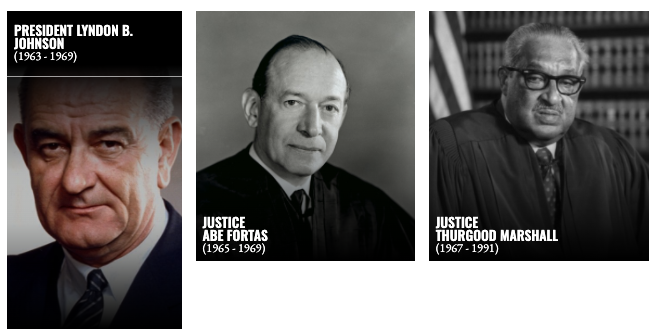The Volokh Conspiracy
Mostly law professors | Sometimes contrarian | Often libertarian | Always independent
Today in Supreme Court History: August 26, 1964
8/26/1964: Lyndon B. Johnson nominated as Democratic candidate for president. He would make two appointments to the Supreme Court: Justices Abe Fortas and Thurgood Marshall.

Editor's Note: We invite comments and request that they be civil and on-topic. We do not moderate or assume any responsibility for comments, which are owned by the readers who post them. Comments do not represent the views of Reason.com or Reason Foundation. We reserve the right to delete any comment for any reason at any time. Comments may only be edited within 5 minutes of posting. Report abuses.
Please to post comments




A couple of other things.
OTD in 1920, the Nineteenth Amendment became official. Happy Women's Equality Day.
https://constitutioncenter.org/blog/why-august-26-is-known-as-womans-equality-day
OTD in 1839 (Wikipedia has a picture of a contemporary painting of the ship) the brig USS Washington seizes the Spanish slaver Amistad, near Montauk Point, N.Y.
It was later the subject of a Supreme Court case & a cameo by Justice Blackmun as Justice Joseph Story [who was over 20 years younger] in the film.
https://www.history.navy.mil/today-in-history/august-26.html
This from Joe’s link to the National Constitution Center:
The 19th Amendment gave women the right to vote nationally on August 18, 1920, so why is Women’s Equality Day on August 26th each year?
The simple answer is that even when a constitutional amendment has been ratified it’s not official until it has been certified by the correct government official.
This is incorrect. An amendment to the Constitution is adopted once it has been submitted to the States and three-fourths of them validly ratify it (see Article V). Certification is simply the federal government’s way of confirming the proposed amendment has been adopted, but the proposal would be adopted even absent the certification. This means the 19th Amendment officially became part of the Constitution on August 18, 2020, and this was certified on August 26, 2020.
“the proposal would be adopted even absent the certification”
If so, it is not compelled by the mere text of Art. V.
It is standard practice to give someone the official role of declaring when certain requirements are met. Things only become official when that act is done. No one else can say “the requirements set forth were accomplished.”
The act here is said to be “ceremonial”, but it need not be.
https://www.archives.gov/federal-register/constitution
[The certification process has changed.]
Anyway, Leser v. Garnett noted:
As the legislatures of Tennessee and of West Virginia had power to adopt the resolutions of ratification, official notice to the Secretary, duly authenticated, that they had done so was conclusive upon him, and, being certified to by his proclamation, is conclusive upon the courts.
The act did have some official significance.
The Supreme Court was citing the notice to the Secretary of State (now it would go to the Archivist of the United States) as evidence that those States had ratified the 19th Amendment, not as a necessary component of ratifying.
Not denied in my comment.
“The act did have some official significance.”
The certification was “conclusive.” If the Secretary (as I said, the process changed) decided the final state did not ratify, it might also be so. The act had official significance.
Thoroughly Bad Marshall, against the Death Penalty, except for the Unborn.
Frank
Beltran v. Smith, 458 U.S. 1303 (decided August 26, 1982): imprisoned gangster, cooperating with prosecutors and in the Witness Protection Program, claims that he will be killed if transferred to another prison; Rehnquist denies stay of transfer order, no showing that program officials will fail to protect him (he served his time and afterward got back into gang activity; in 2009 was killed in a shootout with police)
Just a side note - Josh was quoted in a WaPo story today. It's the one on Smith's appointment.
Often he is quoted because he is a loquacious conservative. This media coverage he earned.
If the National Constitution Center used “official” in a misleading way, it’s granted, but the issue is a bit complicated.
For instance, when did the Constitution bind the states? You might think when the necessary number of states ratified in 1788. See, Art. VII.
Not so according to Owings v. Speed (1820).